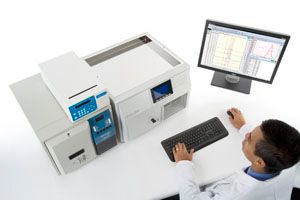Viscotek TDA for GPC/SEC
The Viscotek TDAmax sets the standard in advanced GPC/SEC systems. It is a complete solution, suitable for all macromolecular applications, incorporating high sensitivity refractive index, viscometer, and light scattering detectors.

The Viscotek Triple Detector Array (TDA) employs highly sensitive refractive index, viscometer, and light scattering detectors, and maximises the productivity of GPC/SEC analysis by simultaneously measuring absolute molecular weight, molecular size and intrinsic viscosity.
Inside the TDA is a powerful 7° Low Angle Light Scattering detector (LALS) for the measurement of the absolute molecular weight of even the largest macromolecules, and a 90° Right Angle detector (RALS) for the highest sensitivity measurements of small molecules such as proteins.
Digital inert transducer technology in the viscometer gives a faster, more sensitive response to viscosity changes than traditional transducers. Its 316 stainless steel construction means that there are few limitations, in terms of salt content or pH, on the chromatographic conditions that can be used. Inert capillaries in the measuring flow path are also advantageous for many biomolecule applications.
Suitable for all macromolecular applications, the TDA is available from Malvern Instruments as part of the Viscotek TDAmax system. Alternatively, each element of the TDAmax can be purchased individually offering exceptional flexibility to those with existing GPC/SEC systems. To extend the detection capabilities, the addition of a UV-PDA detector is especially useful for the analysis of the composition of copolymers and/or conjugated proteins.
Malvern Instruments, Malvern, UK
Email: salesinfo@malvern.com
Best of the Week: Food Analysis, Chemical Migration in Plastic Bottles, STEM Researcher of the Year
December 20th 2024Top articles published this week include the launch of our “From Lab to Table” content series, a Q&A interview about using liquid chromatography–high-resolution mass spectrometry (LC–HRMS) to assess chemical hazards in plastic bottles, and a piece recognizing Brett Paull for being named Tasmanian STEM Researcher of the Year.
Using LC-MS/MS to Measure Testosterone in Dried Blood Spots
December 19th 2024Testosterone measurements are typically performed using serum or plasma, but this presents several logistical challenges, especially for sample collection, storage, and transport. In a recently published article, Yehudah Gruenstein of the University of Miami explored key insights gained from dried blood spot assay validation for testosterone measurement.
Determination of Pharmaceuticals by Capillary HPLC-MS/MS (Dec 2024)
December 19th 2024This application note demonstrates the use of a compact portable capillary liquid chromatograph, the Axcend Focus LC, coupled to an Agilent Ultivo triple quadrupole mass spectrometer for quantitative analysis of pharmaceutical drugs in model aqueous samples.